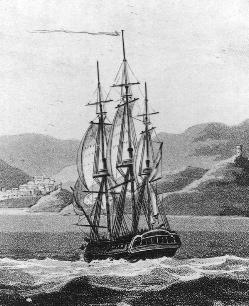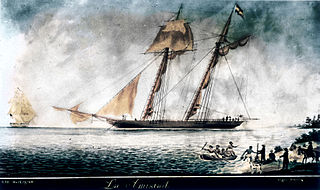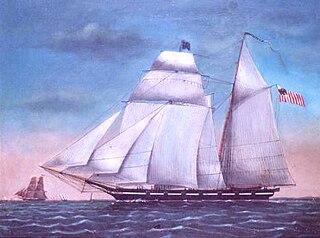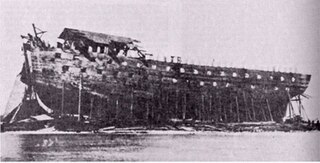
USS Independence was a wooden-hulled, three-masted ship, originally a ship of the line and the first to be commissioned by the United States Navy. Originally a 90-gun ship, in 1836 she was cut down by one deck and re-rated as a 54-gun frigate.

The first USS Raritan was a wooden-hulled, three-masted sailing frigate of the United States Navy built at the Philadelphia Navy Yard, laid down in 1820, but not launched until 13 June 1843, sponsored by Commodore Frederick Engle. She was one of the last sailing frigates of the United States Navy.

USS Columbus was a 90-gun ship of the line in the United States Navy. She was launched on 1 March 1819 by Washington Navy Yard and commissioned on 7 September 1819, Master Commandant J. H. Elton in command.

The third USS Delaware of the United States Navy was a 74-gun ship of the line, named for the state of Delaware.

The second USS Ohio was a ship of the line of the United States Navy, rated at 74 guns, although her total number of guns was 104. She was designed by Henry Eckford, laid down at Brooklyn Navy Yard in 1817, and launched on 30 May 1820. She went into ordinary and in the ensuing years decayed badly. Refitted for service in 1838, Ohio sailed on 16 October 1838 to join the Mediterranean Squadron under Commodore Isaac Hull. Acting as flagship for two years, she protected commerce and suppressed the slave trade off the African coast. Ohio proved to have excellent performance under sail, repeatedly making more than 12 kn. One of her officers stated, "I never supposed such a ship could be built—a ship possessing in so great a degree all the qualifications of a perfect vessel." In 1840, Ohio returned to Boston, where she again went into ordinary. From 1841 to 1846, Ohio served as receiving ship.

USS Philadelphia, a 1240-ton, 36-gun sailing frigate, was the second vessel of the United States Navy to be named for the city of Philadelphia. Originally named City of Philadelphia, she was built in 1798–1799 for the United States government by the citizens of that city. Funding for her construction was the result of a funding drive which raised $100,000 in one week, in June 1798. She was designed by Josiah Fox and built by Samuel Humphreys, Nathaniel Hutton and John Delavue. Her carved work was done by William Rush of Philadelphia. She was laid down about November 14, 1798, launched on November 28, 1799, and commissioned on April 5, 1800, with Captain Stephen Decatur, Sr. in command. She is perhaps best remembered for her burning after being captured in Tripoli.
HMS Sultana was a small Royal Navy schooner that patrolled the American coast from 1768 through 1772. Her role was to prevent smuggling and to collect customs duties. She was retired and sold in 1773 when unrest in Britain's American colonies required larger, better armed patrol craft.

The first USS Alligator was a schooner in the United States Navy, built in 1809 as Gunboat No. 166 and renamed Alligator during the War of 1812. Upon completion she was placed in ordinary at Wilmington, North Carolina. She was commissioned sometime in mid-1809, under Master Commandant Joseph Tarbell.

America was a 19th-century racing yacht and first winner of the America's Cup international sailing trophy.

A Baltimore Clipper is a fast sailing ship historically built on the mid-Atlantic seaboard of the United States of America, especially at the port of Baltimore, Maryland. An early form of clipper, the name is most commonly applied to two-masted schooners and brigantines. These vessels may also be referred to as Baltimore Flyers.

USS Mayflower (PY-1) was the second ship in the United States Navy to have that name. Mayflower was a luxurious steam yacht built in 1896, by J. and G. Thompson, Clydebank, Scotland for millionaire Ogden Goelet, who died on board Mayflower, in August 1897. Her sister ship, said to be almost identical and built at the same time and in the same yard for brother, Robert Goelet, later became USS Nahma.

Washington was a revenue cutter that served in the United States Revenue Cutter Service and in the United States Navy. She discovered, boarded and captured La Amistad after the slaves onboard had seized control of that schooner in an 1839 mutiny.
Samuel Humphreys was a noted American naval architect and shipbuilder in the early 19th century. He served the United States Navy as the Chief Constructor for the Navy from 1826 to 1846.

The United States Revenue Cutter McLane was one of 13 cutters of the Morris-Taney Class to be launched. Named after Secretaries of the Treasury and Presidents of the United States, these cutters were the backbone of the Service for more than a decade. Samuel Humphreys designed these cutters for roles as diverse as fighting pirates, privateers, combating smugglers and operating with naval forces. He designed the vessels on a naval schooner concept. They had Baltimore Clipper lines. The vessels built by Webb and Allen, designed by Isaac Webb, resembled Humphreys' but had one less port.

The first USS New Orleans was a ship-of-the-line intended for use by the United States Navy in the War of 1812. She was never finished.
USS Madison was a U.S. Navy corvette built during the War of 1812 for use on the Great Lakes.
The third USS Warren was a sloop-of-war that served in the United States Navy from 1799 to 1801.
USS Onkahye was a schooner of the United States Navy. A unique ship in the American Navy under sail, the vessel occupied a significant place in ship development, being the only converted sailing yacht to serve on a distant station before the American Civil War. Its design was influential and it is considered the model for modern American sailing yachts.

The Coquette was a 19th-century yacht and pilot boat, built in 1845 by Louis Winde, at the Winde & Clinkard shipyard in Chelsea, Massachusetts for yachtsmen James A. Perkins. Her design was based on a model by shipbuilder Dennison J. Lawlor. The Coquette was a good example of an early American yacht with a clipper bow. As a yacht, she won the attention for outsailing the larger New York yacht Maria at the second New York Yacht Club regatta in 1846. Perkins sold the Coquette to the Boston Pilots' Association for pilot service in 1848. She continued as a pilot boat until 1867 when she was sold as a Blackbirder to be used on the African coast.













